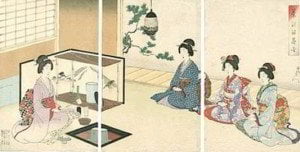Your basket is currently empty!
Japanese tea
Japanese Tea: an Insight
 Here we give an insight into Japanese tea. These teas are highly acclaimed, often noted for their greenness, smooth taste and grassy character.
Here we give an insight into Japanese tea. These teas are highly acclaimed, often noted for their greenness, smooth taste and grassy character.
The main Japanese tea producing regions are Shizuoka and Kagoshima in the south. Most Japanese teas are produced there: Sencha, Bancha, Gyokuro, Kabusecha as well as Kamairicha. Kyoto also called Uji is the region known for growing high-quality teas including Matcha and Gyuokuro. The Mie region produce mainly Kabusecha and Sencha varieties. Finally, the less famous teas of the Nara region including Sencha, Bancha and Kabusecha grow at an altitude between 650 and 1,650 feet on the Yamato plateau. Because the sea is only 75 miles away from the Japanese islands it gives iodized notes and a marine aroma to the tea leaves. The climate is cooler in tea Japanese producing regions, 50°F to 65°F and annual precipitation can be up to 60 inches.
In the 8th Century, under the reign of the emperor Saga, the tea culture in Japan became important. The Japanese began to make powdered tea in the 12th century under the guidance of the monk Elisai. The famous Matcha is produced in the Uji and Shizuoka regions. The soft leaves are steamed, dried and powdered using a small millstone. The first tea master in Japan was Sen No Rikyû, he introduced the Japanese tea ceremony called Cha No Yu inspired from Zen Buddhism. This ceremony is aimed at revealing the magnificance of the tea and also the importance of gestures we can all do daily. During the Cha No Yu, the tea master who wears a kimono uses a bowl, a boiler and a whip. He cleans his utensils in presence of his guests before preparing tea with a precise gesture. Then the host gives a bowl of tea to the guest of honour who will share it with all the other guests. Thus, each guest must drink only a few sips of the beverage.
Gyokuro “Jade Dew” is known as the highest grade of Japanese sencha and originates from Uji, south of Kyoto. It is made only with the first flush leaf and its special processing results in a tea with a sweet, mild flavour and fresh, flowery-green aroma. It contains less tannins and it’s rich in theanine which gives a smooth and umami taste. Gyokuro is a shaded tea, it means that the tea bushes are deprived of light during 3 weeks prior to harvest. This method confers to the Gyokuro its unique flavour and colour and its seaweed scent. Traditionally, the bushes are shaded by straw. This method would produce a better quality of Gyokuro.
Sencha is the most common variety of tea in Japan. “Sencha” could be translated as roasted tea, it refers to an older style of processing green tea inspired by Chinese methods. Today, Sencha is steamed instead of being pan-roasted to avoid oxidation. This tea is noted for its delicate sweetness, grassiness and flowery-green aroma. The first picking of the tea bush in April and May (known as ichi-ban cha), are considered to produce the highest quality Sencha. It produces a bright, luminescent green colour, strong aroma and pronounced sweetness.
Kabusecha is a type of Sencha shaded like Gyokuro during 2 weeks before picking. The Kabusecha tend to have a mellower flavour and subtler colour than sencha grown in direct sunlight.
Bancha could be translated as common tea. It is picked later in October from the same bushes as Sencha teas. Bancha is a lower grade of Sencha, it usually contains larger leaves and upper stems, which are discarded during the production of Sencha. It’s unique flavour is distinguished by a straw scent and it’s much appreciate for it’s more robust flavour. This tea must not be infused over 2 minutes.
Genmaicha is the Japanese name for green tea combined with roasted brown rice. It is sometimes referred to colloquially as “popcorn tea”. It gives a light and yellow brew and it combines the fresh vegetal flavour of the tea leaves and the nutty taste of the rice.
Visit the Japanese Teas section of our Tea Store.
